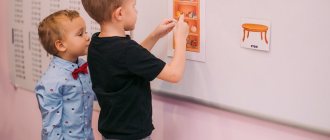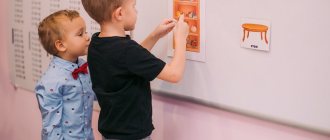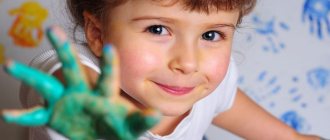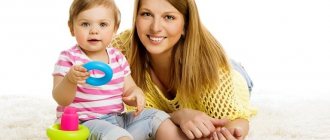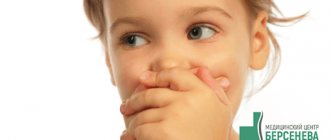The most active period of speech formation is the age of 3-4 years.
At this time, the child takes a huge step forward compared to his previous speech skills. He already knows how to generalize similar objects and phenomena, his speech becomes richer and understandable to others. Speech development is directly related to the mental and intellectual status of the child, so it is important that he does not lag behind age norms. Undoubtedly, each baby develops at its own pace, however, deviations are acceptable only for a couple of months. In order to make sure that speech formation occurs at the right pace, it is necessary to closely monitor the child. Experts recommend starting from the age of one year to be examined by a speech therapist-defectologist. A problem identified in a timely manner is much easier to correct.
Physical development of a 4 year old child
By the age of four, children acquire the following motor skills:
- Confidently jump from a place and from a running start;
- Run, quickly changing direction;
- Stand on one leg;
- Climb a rope ladder;
- Overcome obstacles;
- Walk and stand on tiptoes;
- Tumble forward;
- Ride a scooter and a bicycle with side wheels.
A four-year-old child has fairly well-developed coordination and balance, making various types of physical activity more accessible to the child, such as dancing, gymnastics, and cycling.
The world
Children aged 4 years are actively exploring the world around them. The task of parents is to help them in every possible way in this, replenishing their knowledge base. A 4 year old child should know the following:
- names and purposes of basic household items (dishes, refrigerator, TV);
- several names of trees and flowers;
- names of all parts of the human and animal body and understanding of the differences in the structure of the human body from the body of an animal (hands, paws, nails, claws);
- understand that people and animals, in addition to external organs, also have internal ones, know the names of some of them (heart, brain);
- be able to name and simply describe several professions (driver, doctor), know what parents do;
- distinguish between different types of transport;
- know the names of food products, be able to describe their taste (sweet, salty);
- distinguish the materials from which objects are made (wood, metal, paper);
- be able to name individual parts of an object (cup handle, table leg);
- know your age, city and country of residence;
- understand the main family ties (grandmother is mother’s mother, etc.).
This is the minimum set of knowledge that a four-year-old child should have. Children of this age can know much more. In kindergarten, they study weather phenomena, activities characteristic of different seasons (autumn - harvesting, etc.), the habits of animals and birds, and seasonal holidays.
Four-year-old children already clearly understand their gender roles. Boys know that they are future men, and girls know that they are women. Accordingly, the former begin to be interested in men's activities, and the latter - in women's.
Speech development in children 4 years old
At 4 years old, a child is actively improving phrasal speech; he can speak in sentences of 4 to 8 words. The baby's vocabulary is already about a thousand words. Nouns are used most often, verbs and adjectives are used a little less often. Also, usually at the age of 4 years, children already know how to coordinate parts of speech with each other (for example, a noun and an adjective) and correctly place stress, so their speech sounds more competent than that of younger children. However, complex lexical structures are difficult for four-year-olds, so they often avoid conjunctions “if,” “although,” “otherwise,” etc.
To keep your child’s vocabulary constantly expanding, read books to your child more often, play with him and just talk.
Speech development occurs actively, as children at this age strive to communicate with peers. They ask adults and each other questions, learn to listen and not interrupt the interlocutor. A 4-year-old child can talk about how his day went, share his impressions of a cartoon, or retell the plot of a fairy tale. At the same time, the baby’s intonations can be very diverse, and speech is supported by facial expressions and gestures.
If you notice speech impediments in your four-year-old child, it is recommended that you consult a speech therapist. The specialist will play sounds for the baby, work on articulation and give advice on how to help the child at home.
Logical thinking
At the age of four, visual-effective thinking is complemented by visual-figurative thinking. The baby learns the properties of objects not only by interacting with them, he can already think about them and draw appropriate conclusions.
At four years old, children should be able to:
- find an extra object in a group of similar ones;
- find differences in similar pictures;
- understand what elements are missing in the picture;
- come up with a logical end to a given storyline;
- find a way out of the drawn labyrinth;
- guess an object or animal from a verbal description.
In children, logical thinking develops naturally, from interaction with the world around them. But it can be improved if you work with your baby and play logic games - board and word games.
conclusions
So, 4 years is a period of discovery, both for the baby and for his parents. A four-year-old child actively learns about himself and the world, his abilities and talents manifest themselves. The skills acquired earlier continue to be improved. The child’s intensive physical, mental and personal development occurs: the baby learns to control his body and emotions, memory, attention, thinking, speech and imagination develop. Four-year-olds simply need to communicate with their peers, because the development of children occurs mainly in role-playing games.
Mathematics
Many four-year-old children already count and know numbers. Normally, a child should be able to:
- count to at least five;
- know what numbers from 1 to 5 look like;
- be able to count the number of objects in a picture within five;
- compare groups of objects using the concepts “one”, “many”, “few”;
- know basic geometric shapes (square, circle, triangle).
At this age, kids can count not only to five, but also to ten and even write some numbers.
Vocabulary standards for different ages
Each child develops individually, but there are average indicators that parents can use as a guide:
- one-year-old child – up to 10 words;
- 1.5 years – from 20 to 40 words;
- 2 years – from 50 to 200 words;
- 3 years – up to 1000 words;
- 4 years – 1500-1900;
- 5 years – about 1100-1200;
- 6 years – 3200-3500 words.
When a baby begins to actively talk, his vocabulary is sharply replenished with new words. It increases every year, and by the age of 6-7 years the vocabulary can be more than 3,000 words.
Self-care skills
The foundations of self-care skills are laid at the age of three. By the age of four, children can already perform basic household activities independently, without the help of adults.
The child must be able to:
- brush your teeth, rinse your mouth;
- wash, wash hands, dry with a towel;
- take a shower;
- go to the toilet independently;
- blow your nose into a handkerchief and wipe your nose and mouth;
- use a comb;
- fasten and unfasten buttons, zippers, Velcro;
- putting on and taking off clothes and shoes;
- use cutlery (spoon, fork, mug);
- know where different things are (toiletries, dishes, clothes);
- understand what things can be taken and what cannot;
- put away toys, fold clothes.
Some children at this age enjoy learning more complex household skills - sweeping the floor, dusting, washing dishes. The more adults encourage such activities (naturally, controlling their implementation), the faster the baby develops in everyday life.
Is there a mandatory standard?
All children are different and they develop differently. Therefore, there is no single standard regulating the skills and abilities of a young child.
The Federal State Educational Standard (federal state educational standard) determines the main directions of development of a 4-year-old child. They include basic everyday skills, physical activity, the ability to navigate the world around us, speaking skills, and understanding one’s gender role.
A neurologist monitors the baby’s development from birth. Therefore, parents need to periodically show their child to this specialist. The main function of a neurologist is to observe whether the child is developing correctly in order to identify possible deviations in time.
All the skills described above are not strictly necessary for four-year-old children. Each child develops at his own speed and may know and be able to do more or less than what is specified in the requirements.
Since the leading activity of preschool children is play, it is easier for them to master all new knowledge and skills in a playful form. The task of parents is to find or come up with useful games for the baby.
English language
At preschool age, you can already start learning a foreign language. Kids easily remember words and do not have a psychological barrier that makes it difficult to pronounce the sounds of unfamiliar speech. Therefore, many parents take their children to English courses for preschoolers.
The main difficulty teachers of foreign languages for children face is the difficulty of pronunciation. Not all children even pronounce Russian words correctly, let alone English ones. Another problem is that children often confuse the words of their native and foreign languages.
Children aged four years learning English know the names of various household objects, animals, and primary colors. They are also familiar with the words “mom”, “dad”, “grandfather”, “grandmother”, “brother”, “sister”.
Visual activities
The aesthetic development of a child is as important as the intellectual. Four-year-old children actively develop perception, imagination, and observation skills. Therefore, they can and should be able to transfer their impressions onto paper in the form of a drawing.
In kindergarten, visual arts are an integral part of children's education. It has three directions: subject (image of individual objects), decorative (patterns, ornaments) and plot drawing (objects united by a common storyline).
At 4 years old, a child should be able to:
- draw with pencils, felt-tip pens, paints;
- color coloring books;
- be able to convey the main details in a drawing (on the face - nose, mouth, eyes, ears);
- be able to draw a person, animal, tree.
Visual activity has a positive effect on the development of cognitive processes, so the child’s desire for creativity should be encouraged.
What factors influence speech difficulty?
Let's list the main ones:
1. Organic disorders. They are associated with pathologies of the cerebral cortex. Reasons: • intrauterine pathologies (severe toxicosis, placental abruption, lack of oxygen in the fetus, threat of premature birth and others); • illnesses suffered by the mother during pregnancy (rubella, herpes); • conflict of Rhesus of mother and fetus; • prematurity; • smoking while pregnant; • consumption of alcoholic beverages; • taking medications prohibited for pregnant women; • stress; • depression; • prolonged labor; • heredity (bad bite).
2. Poor social conditions. Main reasons: • weak immune system. The child is often sick for a long time; • disinterest of parents in the development of speech in the child. • bilingualism. Most often occurs if the parents are foreigners; • fright; • incorrect pronunciation of words and phrases by loved ones.
Expert opinion
Margarita Sergeevna S.
Speech pathologist and speech pathologist with 15 years of experience working in various speech correction centers with children of different ages.
Speech is a psychological process. Its correct development depends on many factors. To overcome all obstacles and help a child learn to speak, you need to be in constant contact with him.
Fine motor skills
The development of fine motor skills is directly related to cognitive functions - memory, attention, thinking, speech. Therefore, it is very useful to organize games and activities that develop fine motor skills of the hands - drawing, modeling, assembling mosaics, construction toys.
At four years old, a child should be able to:
- string beads on a thread;
- confidently hold a spoon, pencil, brush in your hand;
- color the drawing without going beyond the contour line;
- cut out the shape along the contour with scissors;
- trace the stencil with a pencil, pen or felt-tip pen;
- sculpt from clay and plasticine, combine molded elements into a single figure;
- thread the lace through the holes.
Finger games, games with sand and molds, and various creative activities are good for developing fine motor skills.




